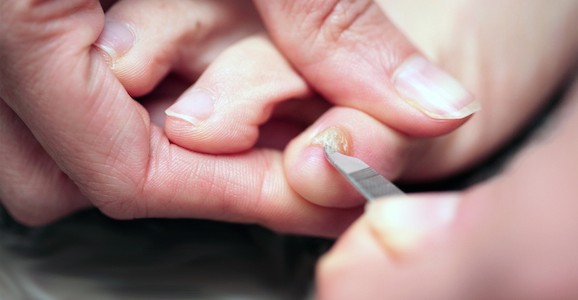Onychomycosis, or fungal infection of the fingernails and toenails, can cause pain, tenderness and an abnormal shape to the nail. The nails appear discolored, thickened, and may have a white, pasty material beneath the nail. Many patients report that onychomycosis significantly hampers their lifestyle.
Many therapies exist for onychomycosis. The major choices are listed below along with the advantages and disadvantages of each therapy. Your physician will work with you in selecting the choice that is best for you. You must return for follow-up visits for any of the therapies listed below.
TOPICAL MEDICATIONS
Most topical medications are only marginally effective. Patients must apply the medications to the nails every day for at least 6 months. Some patients forget to apply the medications, and others become frustrated because improvement is very slow. The medications are generally safe, and patients like them because of the low risk. Improvement is seen in about half of patients. These medications are applied to the sides of the nail and under the end of the nail. Wash your hands after applying these medications.
Mycocide NS® – apply 2 times daily Lamisil® 1% – apply 2 times daily
Fungi-Nail – paint on the edges of the nail at least 1-2 times daily Naftin 1% gel – apply 2 times daily
SURGICAL REMOVAL OF THE NAIL
Some physicians prefer to remove the nail plate before administering topical medications. Removing the nail allows the medication to get into the nail bed where the fungus is growing. Nail removal improves the effectiveness of the topical medications. Some patients do not like the discomfort and the tenderness that lasts for weeks on their toe after the procedure is performed.
ORAL MEDICATIONS
Oral medications have been the most effective therapy. Almost all medications taken by mouth (pills) have the potential for serious side effects, including liver damage. These side effects are uncommon, but some patients do not want to take the risk. The medications may be necessary for up to 1 year to clear the nails.
Gris Peg® 250 mg and 125 mg tablets – 1 of each 2 times a day. Can cause allergic reactions, nausea, diarrhea, stomach- ache, or dizziness. Patients should avoid sunlight while on the medication. At least 6 months of therapy is required.
Sporanox® 400 mg taken daily with food for 1 week out of the month for 4 months total. Can cause headache, upset stomach, or elevated temperature. This is a very successful therapy.
Nizoral® 200 mg taken daily for 6 months. Can cause vomiting, abdominal pain, dizziness, fever, chills, rare allergic reactions, and rare liver problems (1 in 68,000 patients). Best taken with a meal and orange juice.
Republished with the permission of John L. Pfenninger, M.D. – mpcenter.net





